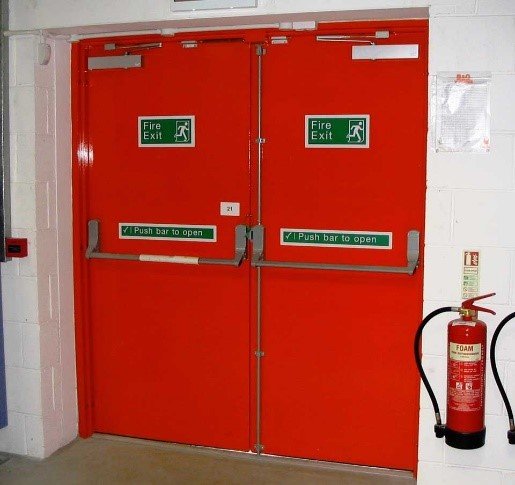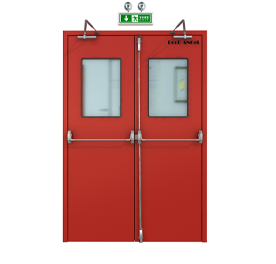Comprehending the Various Kinds of Fire Doors for Enhanced Safety
In the world of structure safety, understanding the various sorts of fire doors is critical. These specialized doors not only act as obstacles versus fire and smoke yet also play a critical role in making certain risk-free emptying during emergencies. From typical fire-rated doors that shield versus flames to acoustic fire doors that provide both fire resistance and audio insulation, each kind is designed with particular functions in mind. The integration of glass fire doors and the necessity of fire departure doors better highlight the multifaceted nature of fire door applications. What crucial facets must center managers consider to make best use of the effectiveness of these lifesaving barriers?
Criterion Fire-Rated Doors
Typical fire-rated doors are an essential element in making certain building security and conformity with fire laws. These doors are specifically designed to stand up to the spread of fire and smoke, providing essential defense to residents and home. Created from materials such as steel, plaster, and fireproof wood, they can hold up against high temperatures and keep structural stability for differing periods, typically ranging from 20 minutes to three hours.
The effectiveness of basic fire-rated doors is evaluated by their fire-resistance rating, which is established through extensive testing under controlled problems. This score shows the duration throughout which the door can contain flames and heat, thereby allowing additional time for evacuation and emergency response. In addition, these doors usually include intumescent seals that broaden when exposed to heat, further avoiding the passage of smoke and toxic gases.
Installment of common fire-rated doors need to abide by stringent building ordinance and requirements, such as those set by the National Fire Defense Organization (NFPA) and the International Building Ordinance (IBC) Normal evaluations and maintenance are vital to make certain that these doors operate correctly in an emergency situation. Appropriately installed and preserved fire-rated doors are essential in boosting total structure safety and reducing fire-related dangers.
Smoke Doors
Smoke doors play a critical duty in fire security by specifically attending to the control of smoke, which is usually much more hazardous than flames during a fire case. Smoke inhalation can lead to severe breathing concerns, disorientation, and even fatalities, making smoke doors a crucial element in emergency preparation. These doors are created to restrict the movement of smoke in between various areas within a structure, thus providing much safer emptying routes and minimizing prospective damage to building.

Furthermore, smoke doors are commonly outfitted with automated closing systems, set off by smoke detectors or emergency alarm, to ensure they close promptly throughout an emergency. By including smoke, these doors help preserve lower temperatures and more clear presence in escape courses, making them an indispensable component in thorough fire safety approaches. Their correct setup and upkeep are vital to make certain ideal performance when most required.
Acoustic Fire Doors
Acoustic fire doors give a double function in both fire security and audio depletion, making them a valuable addition to structures where sound control is important. These doors are engineered to not just satisfy rigorous fire resistance criteria but also to significantly reduce audio transmission, thereby boosting overall structure performance.
The construction of acoustic fire doors usually involves a combination of thick products and specialized seals. These components collaborate to develop an effective obstacle against both fire and noise. High-density cores, such as mineral boards or composite materials, are typically used in the door fallen leave to make the most of sound insulation. Furthermore, the door framework and seals are developed to maintain acoustic integrity while offering durable fire resistance.
Acoustic fire doors are especially helpful in atmospheres where privacy and peaceful are critical, such as medical facilities, resorts, and universities. They help to maintain a calm atmosphere by minimizing the transmission of audio in between spaces or corridors while ensuring conformity with fire safety regulations. In enhancement to their practical benefits, these doors can be customized to blend flawlessly with the architectural looks of a building, making sure that safety does not come at the expense of design.

Glass Fire Doors
Glass fire doors, often used in modern-day building designs, offer a mix of openness and security that conventional fire doors can not match. These doors combine the visual appeal of glass with important fire-resistant properties, making them an ideal selection for contemporary buildings. Engineered with specialized fireproof glazing, glass fire doors can endure heats and stop the spread of flames and smoke for a defined period, usually varying from 30 to 120 minutes.
The construction of glass fire doors entails several layers of tempered glass, commonly treated with intumescent materials that expand when subjected to heat, more improving their fireproof abilities. These doors are not just practical in regards to fire safety yet likewise permit natural light to penetrate with rooms, adding to energy performance and a much more inviting environment.
In addition, glass fire doors can be integrated with different framework materials such as steel or light weight aluminum, which supply extra architectural support and longevity. Using such doors is specifically beneficial in industrial, educational, and health care settings where presence and safety are vital. By fulfilling strict fire security laws and maintaining an open, contemporary visual, glass fire doors stand for a critical innovation in fire-resistant building and construction.

Fire Exit Doors
Fire escape doors are a crucial part of any structure's safety and security framework, created to provide a swift and secure means of egress throughout emergencies. These doors are strategically situated to make sure residents can quickly and securely evacuate the facilities in the occasion of a fire or various other harmful situations. Unlike basic doors, fire escape doors should follow rigid regulatory criteria, ensuring they can carry out reliably under pressure.
A key function of fire escape doors is their capability to open quickly from the within, usually equipped with panic bars or press pads. This design facilitates quick emptying and my explanation protects against bottlenecks that can happen throughout high-stress circumstances. Furthermore, fire exit doors are commonly constructed advice from fire-resistant products to stop the spread of flames and smoke, therefore offering essential additional time for evacuation and firefighting efforts.
One more vital aspect is the clear signage and lighting connected with fire escape doors. Appropriate signs ensures that these departures are conveniently recognizable even in low-visibility conditions. Routine upkeep and examinations are essential to ensure that these doors work appropriately when needed. Ultimately, the efficiency of fire departure doors is an essential component in safeguarding lives and reducing residential or commercial property damages throughout emergency situations.
Conclusion
In summary, understanding the different sorts of fire doors, including conventional fire-rated doors, smoke doors, acoustic fire doors, glass fire doors, and fire departure doors, is vital for improving security in buildings. Each type provides particular benefits, from fire and smoke containment to appear insulation and visual combination, making sure you can try these out detailed security. Fire doors. Regular upkeep and compliance with security standards are necessary to ensure their effectiveness in safeguarding residents and facilitating secure emptying during emergency situations
Comments on “Fire Doors: Just How They Add To Fire Safety And Security and Legal Conformity”